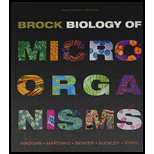
Brock Biology of Microorganisms, MasteringMicrobiology with eText and Access Card (14th Edition)
14th Edition
ISBN: 9780133857276
Author: Michael Madigan
Publisher: PEARSON
expand_more
expand_more
format_list_bulleted
Concept explainers
Question
Chapter 17.6, Problem 2MQ
Summary Introduction
Oomycetes belong to the group Stramenopiles. These organisms are also called “water molds”. The oomycetes are eukaryotic organisms and are the inhabitants of both terrestrial and aquatic environment. The members of oomycetes are microscopic and filamentous and they show absorptive mode of nutrition. In them, the reproduction takes place via both asexual and sexual means.
Expert Solution & Answer
Want to see the full answer?
Check out a sample textbook solution
Students have asked these similar questions
In what ways do oomycetes differ from and resemble fungi?
Does mushrooms belong to basidiomycetes?
What are the economic importance of zygomycetes?
Chapter 17 Solutions
Brock Biology of Microorganisms, MasteringMicrobiology with eText and Access Card (14th Edition)
Ch. 17.1 - Prob. 1MQCh. 17.1 - Prob. 2MQCh. 17.1 - Prob. 3MQCh. 17.2 - Prob. 1MQCh. 17.2 - Prob. 2MQCh. 17.2 - Prob. 3MQCh. 17.3 - Prob. 1MQCh. 17.3 - Prob. 2MQCh. 17.4 - Contrast the two nutritional options for Euglena.Ch. 17.4 - Prob. 2MQ
Ch. 17.4 - Prob. 3MQCh. 17.5 - Prob. 1MQCh. 17.5 - Prob. 2MQCh. 17.5 - What are apicoplasts, which organisms have them,...Ch. 17.6 - Prob. 1MQCh. 17.6 - Prob. 2MQCh. 17.6 - Prob. 3MQCh. 17.7 - Prob. 1MQCh. 17.7 - How are chlorarachniophytes thought to have...Ch. 17.8 - Prob. 1MQCh. 17.8 - Compare and contrast the lifestyles of gymnamoebas...Ch. 17.8 - Prob. 3MQCh. 17.9 - What are conidia? How does a conidium differ from...Ch. 17.9 - Prob. 2MQCh. 17.9 - Prob. 3MQCh. 17.10 - Why is the mold Penicillium economically...Ch. 17.10 - Prob. 2MQCh. 17.10 - Prob. 3MQCh. 17.11 - Prob. 1MQCh. 17.11 - Prob. 2MQCh. 17.11 - Prob. 3MQCh. 17.12 - Prob. 1MQCh. 17.12 - Prob. 2MQCh. 17.12 - Prob. 3MQCh. 17.13 - Prob. 1MQCh. 17.13 - Prob. 2MQCh. 17.14 - Prob. 1MQCh. 17.14 - Prob. 2MQCh. 17.15 - What traits link cyanobacteria and red algae?Ch. 17.15 - Prob. 2MQCh. 17.16 - What phototrophic properties link green algae and...Ch. 17.16 - What is unusual about the green algae...Ch. 17.16 - Prob. 3MQCh. 17 - Prob. 1RQCh. 17 - Prob. 2RQCh. 17 - Prob. 3RQCh. 17 - Prob. 4RQCh. 17 - Prob. 5RQCh. 17 - Three groups make up the alveolates: ciliates,...Ch. 17 - Prob. 7RQCh. 17 - REVIEW QUESTIONS
8. What morphological trait...Ch. 17 - Prob. 9RQCh. 17 - Prob. 10RQCh. 17 - Prob. 11RQCh. 17 - Prob. 12RQCh. 17 - Prob. 13RQCh. 17 - Prob. 14RQCh. 17 - Prob. 15RQCh. 17 - Prob. 16RQCh. 17 - Green algae are common in aquatic environments and...Ch. 17 - Explain why the process of endosymbiosis can be...Ch. 17 - Summarize the evidence for endosymbiosis. How...
Knowledge Booster
Learn more about
Need a deep-dive on the concept behind this application? Look no further. Learn more about this topic, biology and related others by exploring similar questions and additional content below.Similar questions
arrow_back_ios
arrow_forward_ios
Recommended textbooks for you
 Biology: The Dynamic Science (MindTap Course List)BiologyISBN:9781305389892Author:Peter J. Russell, Paul E. Hertz, Beverly McMillanPublisher:Cengage Learning
Biology: The Dynamic Science (MindTap Course List)BiologyISBN:9781305389892Author:Peter J. Russell, Paul E. Hertz, Beverly McMillanPublisher:Cengage Learning Biology (MindTap Course List)BiologyISBN:9781337392938Author:Eldra Solomon, Charles Martin, Diana W. Martin, Linda R. BergPublisher:Cengage Learning
Biology (MindTap Course List)BiologyISBN:9781337392938Author:Eldra Solomon, Charles Martin, Diana W. Martin, Linda R. BergPublisher:Cengage Learning

Biology: The Dynamic Science (MindTap Course List)
Biology
ISBN:9781305389892
Author:Peter J. Russell, Paul E. Hertz, Beverly McMillan
Publisher:Cengage Learning

Biology (MindTap Course List)
Biology
ISBN:9781337392938
Author:Eldra Solomon, Charles Martin, Diana W. Martin, Linda R. Berg
Publisher:Cengage Learning